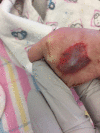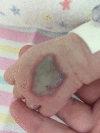Comparing ivWatch biosensor to standard care to identify extravasation injuries in the paediatric intensive care: a protocol for a randomised controlled trial
- PMID: 35190407
- PMCID: PMC8862432
- DOI: 10.1136/bmjopen-2020-047765
Comparing ivWatch biosensor to standard care to identify extravasation injuries in the paediatric intensive care: a protocol for a randomised controlled trial
Abstract
Introduction: Peripheral intravenous catheters (PIVCs) frequently fail during therapy administration, resulting in infusates pooling in the surrounding tissue. These extravasation injuries can cause significant pain, tissue destruction and scarring. ivWatch is a biosensor that uses visible and near-infrared light to measure tissue changes surrounding the PIVC and alert clinicians when extravasation may occur. The effectiveness of ivWatch, in comparison to clinical observation, in decreasing injury severity is unknown. The present study aims to investigate whether using ivWatch may potentially detect injury earlier and decrease the severity of PIVC extravasation injuries.
Methods and analysis: A single centre, parallel group, open-label superiority randomised controlled trial comparing (a) standard care (clinical observation) to (b) ivWatch monitoring in addition to standard care, to decrease the severity of extravasation injuries. 200 children with PIVCs inserted in the distal half of the limb, receiving intermediate-risk to high-risk infusates for ≥24 hours, will be consecutively recruited at a paediatric intensive care unit in Queensland, Australia. The primary outcome is extravasation severity, measured by the Cincinnati Children's Extravasation Harm Scale. Secondary outcomes include severity assessed with three-dimensional camera imaging, extravasation volume, treatment sequelae, the number of PIVCs used and dwell time, quality of life and healthcare costs. The between treatment difference in extravasation severity will be compared using ordinal logistic regression, with the treatment group included as the main effect, and reported with corresponding 95% CIs. Estimates of value will be presented as net monetary benefits and cost per reduction in extravasation injury severity, both presented with corresponding 95% credible intervals.
Ethics and dissemination: This study received approval from the Children's Health Queensland Hospital and Health Service Human Research Ethics Committee (HREC) (reference number: HREC/20/QCHQ/60867) and the Griffith University HREC (reference number: 2020/310) and will be disseminated via peer-reviewed publications and conference presentations.
Trial registration number: ACTRN12620000317998.
Keywords: health economics; paediatric intensive & critical care; preventive medicine; qualitative research; wound management.
© Author(s) (or their employer(s)) 2022. Re-use permitted under CC BY-NC. No commercial re-use. See rights and permissions. Published by BMJ.
Conflict of interest statement
Competing interests: CAM reports travel and accommodation expenses from Roche and Smith & Nephew (unrelated to the current project), and a research grant provided to the Pegg Leditschke Children’s Burns Centre from Abigo Medical AB (unrelated to the current project). JAS reports investigator-initiated research grants provided to Griffith University from BD-Bard (unrelated to the current project). TK reports investigator-initiated research grants and speaker fees provided to Griffith University from 3M Medical, Angiodynamics, Baxter, BD-Bard and Medical Specialties Australia (unrelated to the current project). JB reports investigator-initiated research grants provided to Griffith University from Becton Dickinson and Navi Technologies (unrelated to current project). AJU reports investigator-initiated research grants and speaker fees provided to Griffith University from 3M Medical, Becton Dickinson, Cardinal Health and Navi Technologies (unrelated to the current project). The other authors have no conflicts of interest to declare.
Figures





References
Publication types
MeSH terms
LinkOut - more resources
Full Text Sources
